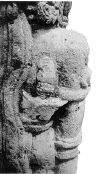IV-
BIRTH OF THE MODERN KERIS
The Keris as
we know it today is the result of a long evolution. It
has probably slowly evolved from a short blade leaf shaped
dagger, to a proto Buda Keris (10th
century) with some dapur characteristics, but still used
as a stabbing dagger. The modern Keris is a unique thrusting
dagger. It has reached its current shape during the Majapahit Realm (14th
century) and
its height during the Mataram Kingdom (17-18th
century).
In other parts of
the archipelago it has evolved in other thrusting daggers (the Badik
in Sulawesi, the Rencong
in Aceh, the Sewar
in Minangkabau or the Kujang in West Java), they probably all
have common origins.
One of
the specificity of the Keris is its
connection with the serpent deity Naga. A Chinese
monk, I- Ching, who lived in Java during the late 7th century noticed
the local Buddhism possessed a unique characteristic: praying Naga
deities. According to the tradition, the straight
Keris represents a still serpent, whereas the wavy represent a moving
serpent. The Naga is often represented on Keris blades.


 The Yogyakarta Sonobudaya Museum, has
a 15th
century sculpture representing Bima with a dagger on its back. Although the blade
can not be seen, the sheath, the hilt and the Mendak are characteristic
of the Keris.
The Yogyakarta Sonobudaya Museum, has
a 15th
century sculpture representing Bima with a dagger on its back. Although the blade
can not be seen, the sheath, the hilt and the Mendak are characteristic
of the Keris.